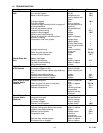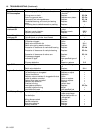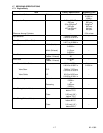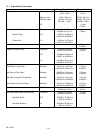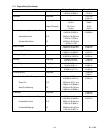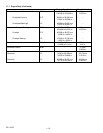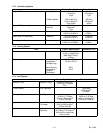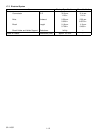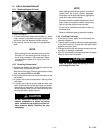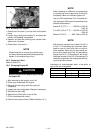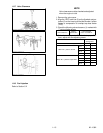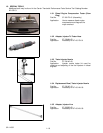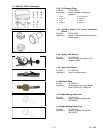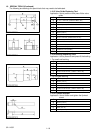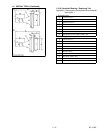
1--13 62--11362
1.8 CHECK AND MAINTENANCE
1.8.1 Checking Engine Oil Level
1. Level the engine.
2. To check the oil level, draw out the dipstick (1), wipeit
clean, reinsert it, and draw it out again. Check to s ee
that the oil level lies between the two notches.
3. If the level is too low, add new oil to the specified
level.
NOTE
When adding oil to the crankcase, be sure that
the fresh oil is the same type and viscosity as
the o il that is already in the crankcase. Never
mix two different types of oil. Never over fill a
crankcase.
1.8.2 Checking Coolant Level
1. Remove the radiator cap and check to see that the
coolant level is just below the port.
With the r ecovery t ank: Check to s ee that the coolant
level lies between FULL and LOW.
2. If the coolant level is too low, check the reason for the
lost coolant.
a. If coolant loss is due to evaporation, add only clean
soft water.
b. If coolant loss is due to a leak, repair the leak, then
add a coolant mixture of the same type and specifi-
cation that is in the system. If the coolant brand can-
not be identified, drain out all of the remaining cool-
ant and refill with a totally new mix.
CAUTION
Do not remove the radiator cap until the
coolant temperature is below its boiling
point. Loosen the cap slightly to relieve ex-
cess pressure before removing the cap
completely.
NOTE
When adding coolant to thesystem,air must be
vented from the engine coolant passages.
Venting air can b e accomplished by jiggling the
upper and lower radiator hoses.
Be sure to close the radiator cap securely. If the
cap is loose or improperly closed, coolant may
leak out and the engine could overheat.
Do not use an antifreeze and scale inhibitor at
thesametime.
Never mix different types or brands of coolants.
1.8.3 Checking Fuel Hose
1. If the clamp is loose, apply oil to the threads and
securely retighten it.
2. The fuel hose is made of rubber and ages regardless
of the service period. Change the hose and clamps
together every two years.
3. Change the fuel hose and clamps whenever any de-
terioration or damage is detected.
4. After the fuel hose and clamps have been changed,
bleed air out of the fuel system.
CAUTION
Stop the engine when attempting to check
and change the fuel line.



